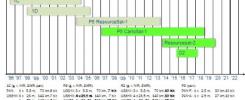A year of achievements and Copernicus plans for 2018
23 January 2018
If 2017 has been a landmark year in the history of the Copernicus programme, more will come in 2018. In an Editorial published on 12/01/2018, Philippe Brunet, Director for Space Policy Copernicus and Defence at EC's DG GROW explains.
The offer of products and services has dramatically increased
There is now over 743 Copernicus information products – actio nable geoinformation and intelligence - that are available from Copernicus for the support of environmental security and policies. And there is six core Copernicus services impacting citizens’ lives and the EU’s global footprint; Among them,
- The Emergency Management Service (EMS) Mapping component was activated 80 times.
- The Land Monitoring Service now delivers over 20 variables linked to the water, energy, vegetation and cryosphere domains
- The Marine Environmental Monitoring Service released new waves observations and forecasts, as well as ocean monitoring indicators (OMIs). The first Annual Ocean State Report was published.
- The Climate Change Service started delivering monthly temperature anomalies maps as well as seasonal forecasts.
The Sentinel family grows and creates a new paradigm in data access and distribution
Sentinel-2B joined the Copernicus constellation.It is now possible to deliver free and open data with a 5-day revisit time from both optical and SAR instruments.n addition, Sentinel-5P was launched in October, further developing the Copernicus observation capabilities and providing reliable and timely information about atmospheric pollutants on a global scale.
The six Copernicus satellites currently in orbit are producing over 12 TB of high-quality full, free, and open Earth Observation data every day. It is something like 6,000 DVDs per day. While this creates complex logistical challenges in a big data setting, it creates also opportunities: The European Commission launched the Copernicus Data and Information Access Services (DIAS) to develop cloud-enabled platforms to access and process Copernicus data in few clicks.
The Copernicus market is now developping
Such development benefits from 3 key ideas - to ensure access to Copernicus data and information, to increase awareness and use, and to boost innovation - and several activities, initiatives and instruments:
- The Copernicus Relays, the Copernicus Academy and the Copernicus Support Office
- The Copernicus Accelerator and the newly-launched Copernicus Incubation programme
- The Copernicus Skills programme
- Eleven Copernicus Climathons
- Organisation of key events across Europe.
Copernicus is more than an EU programme operating within European borders
Copernicus Cooperation Arrangements were signed with USA and Australia, and negotiations are ongoing with 8 countries/institutions.
For 2018, resolutions are focused on the tasks and challenges ahead
- Launch of Sentinel-3B.
- DIAS to become operational. By second quarter of 2018, five DIAS services will become available to users
- Copernicus Training and Information Sessions
- Copernicus Space Component evolution
To know more: http://copernicus.eu/news/editorial-2017-achievements





























